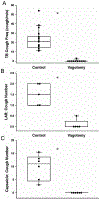Influence of intrathoracic vagotomy on the cough reflex in the anesthetized cat
- PMID: 34678475
- PMCID: PMC8742786
- DOI: 10.1016/j.resp.2021.103805
Influence of intrathoracic vagotomy on the cough reflex in the anesthetized cat
Abstract
Recurrent laryngeal afferent fibers are primarily responsible for cough in response to mechanical or chemical stimulation of the upper trachea and larynx in the guinea pig. Lower airway slowly adapting receptors have been proposed to have a permissive effect on the cough reflex. We hypothesized that vagotomy below the recurrent laryngeal nerve branch would depress mechanically or chemically induced cough. In anesthetized, bilaterally thoracotomized, artificially ventilated cats, thoracic vagotomy nearly eliminated cough induced by mechanical stimulation of the intrathoracic airway, significantly depressed mechanically stimulated laryngeal cough, and eliminated capsaicin-induced cough. These results support an important role of lower airway sensory feedback in the production of tracheobronchial and laryngeal cough in the cat. Further, at least some of this feedback is due to excitation from pulmonary volume-sensitive sensory receptors.
Keywords: Cough; Pulmonary stretch receptor; Recurrent laryngeal afferent.
Copyright © 2021 The Authors. Published by Elsevier B.V. All rights reserved.
Conflict of interest statement
Declaration of Competing Interest
None.
Figures




Similar articles
-
Neurophysiology of the cough reflex.Eur Respir J. 1995 Jul;8(7):1193-202. doi: 10.1183/09031936.95.08071193. Eur Respir J. 1995. PMID: 7589405 Review.
-
Vagal afferent nerves regulating the cough reflex.Respir Physiol Neurobiol. 2006 Jul 28;152(3):223-42. doi: 10.1016/j.resp.2006.03.001. Epub 2006 Jun 5. Respir Physiol Neurobiol. 2006. PMID: 16740418 Review.
-
Differential effects of airway afferent nerve subtypes on cough and respiration in anesthetized guinea pigs.Am J Physiol Regul Integr Comp Physiol. 2008 Nov;295(5):R1572-84. doi: 10.1152/ajpregu.90382.2008. Epub 2008 Sep 3. Am J Physiol Regul Integr Comp Physiol. 2008. PMID: 18768768 Free PMC article.
-
Identification of the tracheal and laryngeal afferent neurones mediating cough in anaesthetized guinea-pigs.J Physiol. 2004 Jun 1;557(Pt 2):543-58. doi: 10.1113/jphysiol.2003.057885. Epub 2004 Mar 5. J Physiol. 2004. PMID: 15004208 Free PMC article.
-
Changes in vagal afferent drive alter tracheobronchial coughing in anesthetized cats.Respir Physiol Neurobiol. 2016 Aug;230:36-43. doi: 10.1016/j.resp.2016.05.008. Epub 2016 May 13. Respir Physiol Neurobiol. 2016. PMID: 27184303
Cited by
-
Hypotussic cough in persons with dysphagia: biobehavioral interventions and pathways to clinical implementation.Front Rehabil Sci. 2024 Jun 12;5:1394110. doi: 10.3389/fresc.2024.1394110. eCollection 2024. Front Rehabil Sci. 2024. PMID: 38933659 Free PMC article. Review.
-
Chronic cough-the limitation and advances in assessment techniques.J Thorac Dis. 2022 Dec;14(12):5097-5119. doi: 10.21037/jtd-22-874. J Thorac Dis. 2022. PMID: 36647459 Free PMC article. Review.
-
Identifying vagal bronchopulmonary afferents mediating cough response to inhaled sulfur dioxide in mice.Am J Physiol Regul Integr Comp Physiol. 2024 Jul 1;327(1):R79-R87. doi: 10.1152/ajpregu.00281.2023. Epub 2024 May 20. Am J Physiol Regul Integr Comp Physiol. 2024. PMID: 38766774 Free PMC article.
-
Neuroendocrine cells initiate protective upper airway reflexes.Science. 2024 Apr 19;384(6693):295-301. doi: 10.1126/science.adh5483. Epub 2024 Apr 18. Science. 2024. PMID: 38669574 Free PMC article.
References
-
- Atzori L, Bannenberg G, Corriga A, Moldeus P, Ryrfeldt Å, 1992. Sulfur dioxide-induced bronchoconstriction in the isolated perfused and ventilated guinea-pig lung. Respiration 59, 16–21. - PubMed
-
- Bolser DC, Lindsey BG, Shannon R, 1988. Respiratory pattern changes produced by intercostal muscle/rib vibration. J. Appl. Physiol 64, 2458–2462. - PubMed
-
- Canning BJ, 2011. Functional implications of the multiple afferent pathways regulating cough. Pulm. Pharmacol. Ther 24, 295–299. - PubMed
-
- Canning BJ, Mori N, Mazzone SB, 2006. Vagal afferent nerves regulating the cough reflex. Respir. Physiol. Neurobiol 152, 223–242. - PubMed
Publication types
MeSH terms
Grants and funding
LinkOut - more resources
Full Text Sources
Medical
Miscellaneous

